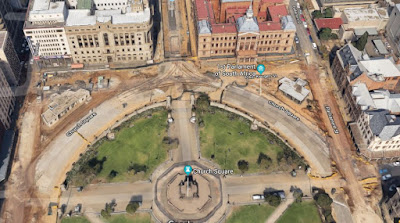 |
| The old tram tracks uncovered in Church Square |
The tracks are in a surprisingly good condition and will be preserved. This discovery highlighted some aspects of Pretoria’s early days of transport with a direct link to the suburb of Arcadia.
 |
| A view from Google Maps clearly showing the exposed tracks |
Public transport in Pretoria began in 1897 with the establishment of the Pretoria Tramway company which had 8 trams and 50 horses.
 |
| Horse drawn tram in Church Square |
 |
| Map of Church Square showing the tram line |
 |
| Electric tram in Church Square |
Later a track was laid to the Union Buildings. Mr Courtenay Smithers, who lived with his parents at 555 Vermeulen Street in 1913, vividly recalls the trams and in particular, the little tram that made its way up to the Union Buildings.
“For most of the day (and only on working days, if I remember correctly) there was only one tram which made the short run from Church Street to the Union Buildings and back, a small one which would carry only half the number of passengers which the usual “big” trams would carry. This small tram ran along Leyds Street to Vermeulen Street and wound its way up the hill to join the road which ran along in front of the Union Buildings.
Now there is a road that follows the curving route up the hill where the little tram took its slow climb up the hill, making a whining noise in its low gear. Keeping up with the struggling tram was easy. In those days the tram line passed between the pine trees of the plantation that grew on the hillside. One of the boys who lived in Hamilton Avenue was a good shot with a “catty” and he enjoyed showing off his skill by bringing down a dove or two from the pines. The driver of the tram didn’t like the boy; I suspect he was worried in case the boy let fly at him or the tram, but he never did.
Small boys usually know where to “draw the line”. Inevitably, small boys being small boys, we sometime put a little stone on the line for the tram to crush (with a loud bang of course) as it went over it.
 |
| Tram in Paul Kruger Street |
We had our special hiding places amongst the trees where we couldn't be seen but from where we could have a good view of the tram. The surly driver never caught us at our mischief but he must have suspected we were the culprits. We occasionally sacrificed a penny from our meagre pocket money and put it on the line so that it was squashed and flattened.
Occasionally we lost our penny because it stuck to the tram wheel and was taken away instead of sticking to the rails.”
“At peak passenger times, when the office workers arrived and left the Union Buildings, the small tram was supplemented by a couple of big trams to provide enough space to cope with the extra passengers to and from Church Street where they could catch trams which took them into town and elsewhere.”

In 1935 trams were supplemented by double-decker buses. The last tram trip was in August 1939.
One of the original trams is parked at Klapperkop
 |
| Coach at Fort Klapperkop |
(Source: www.sa-transport.co.za)

No comments:
Post a Comment